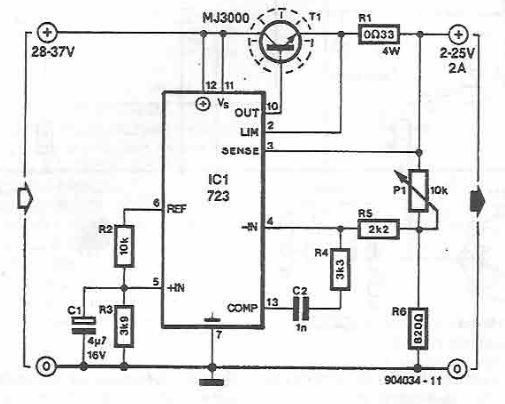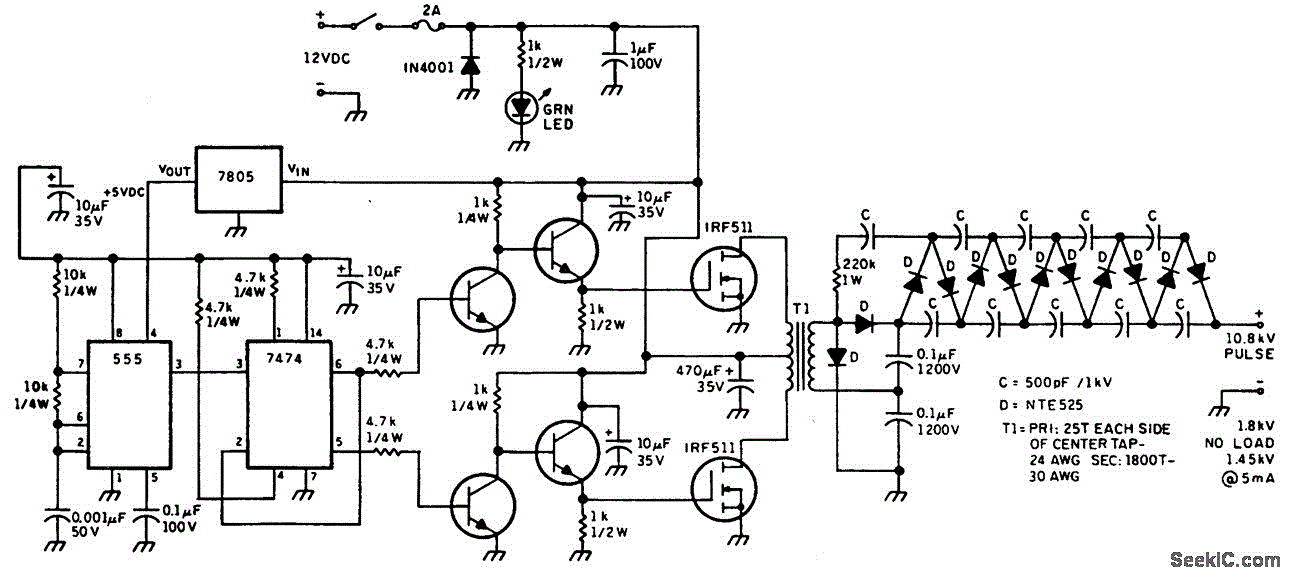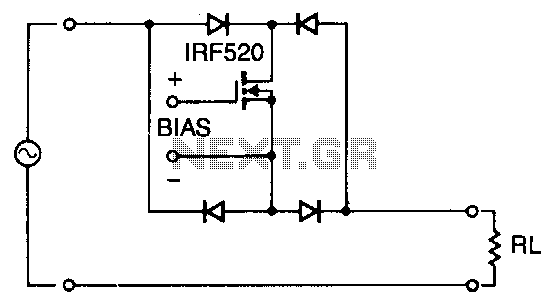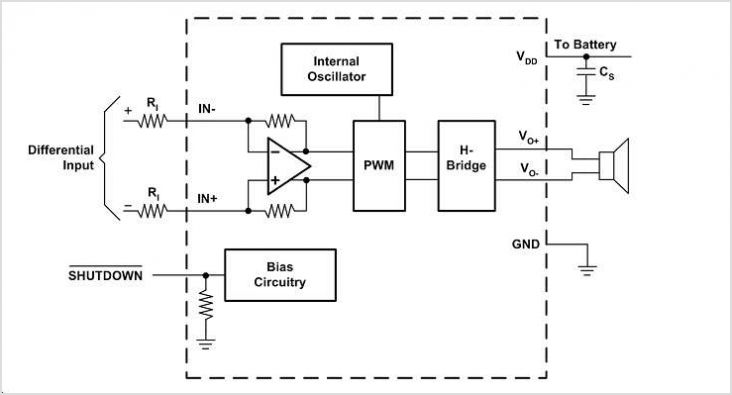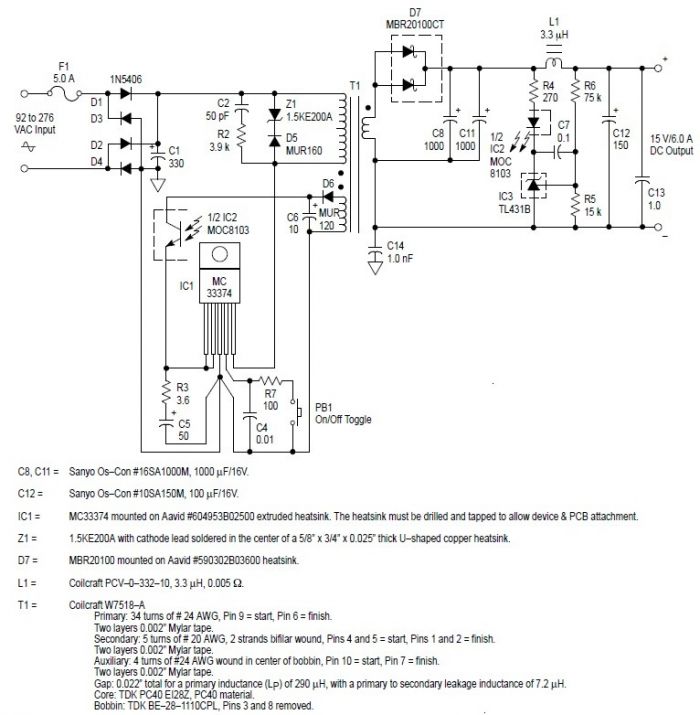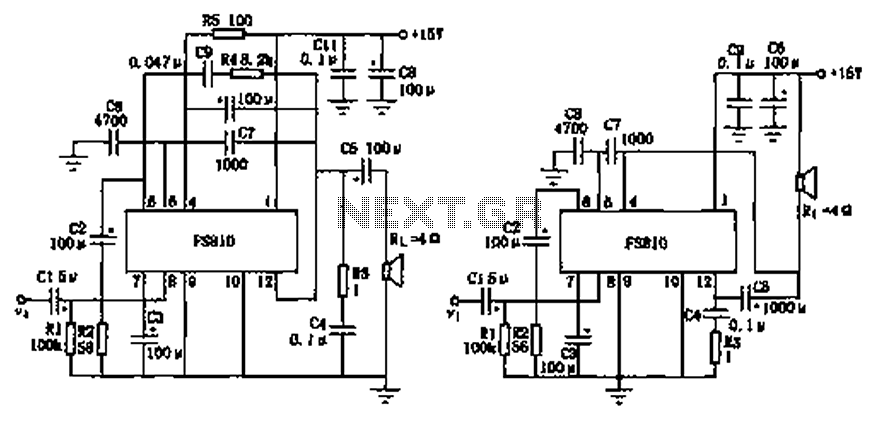
13.8V 20A linear power supply

The presented design features an unconventional arrangement that provides certain advantages compared to traditional designs. To begin with, a linear power supply incorporates a transformer that steps down the line voltage to a level higher than the regulated output voltage required. Subsequently, a rectifier and filter capacitor convert the low voltage AC into moderately filtered DC, which remains unregulated and exhibits some ripple. A regulating circuit then dissipates the excess voltage, delivering the precise output voltage needed, typically 13.8V for communication equipment. A common error among amateur designers is selecting a transformer with an insufficient voltage for the combination of rectifier, filter, and regulator used. The output voltage must remain at 13.8V consistently, while the regulator requires a minimum voltage drop, often around 2V. Therefore, a minimum of 15.8V is necessary across the filter capacitor during low ripple conditions. The capacitor must be charged to accommodate the maximum ripple voltage, and its size influences the additional voltage required. For instance, a 60000uF capacitor, operating at 20A and discharging over nearly half a cycle at 50Hz (10ms), experiences a voltage drop of approximately 3.3V. Consequently, the capacitor needs to be charged to at least 19.2V under the worst-case scenario. When utilizing a bridge rectifier composed of silicon diodes, which incur a voltage drop of about 1.2V each at peak current, two diodes will conduct during capacitor charging, resulting in a total drop of 2.4V. Thus, the transformer must produce a peak voltage of 21.6V. This requirement is especially critical under heavy load conditions, as the capacitor charging occurs over a short duration, leading to significant voltage drops in the transformer, estimated at 10% to 15% depending on its size. Therefore, a transformer that outputs around 24 to 25V peak voltage is necessary. Additionally, consideration must be given to the stability of the power line supplying the design. Allowing for a 10% worst-case sag in the power line necessitates a transformer that, under nominal line voltage and light load, provides approximately 27V peak, translating to 19V RMS. If a transformer with a lower rating, smaller filter capacitor, or regulator with a higher minimum voltage drop is employed, the power supply may lose regulation under certain conditions, a common issue encountered by amateur designers. Conversely, utilizing a regulator with a lower voltage drop and/or a larger filter capacitor can alleviate the transformer voltage requirements, which is beneficial for maintaining the filter capacitor's voltage rating at 25V. This avoids the need for a 35V capacitor, which is bulkier and more expensive. A lower transformer voltage also enhances efficiency, as the excess voltage must be dissipated by the regulator, resulting in significant power loss and necessitating a large heat sink. Furthermore, the choice of pass elements for the regulator is crucial. MOSFETs are typically not favored due to their higher costs compared to bipolar transistors for equivalent voltage drop and power dissipation. Therefore, bipolar transistors are predominantly used in power supplies, with NPN transistors generally preferred over PNP types due to their lower cost for comparable performance and broader availability.
The linear power supply circuit begins with a transformer that converts the high-voltage AC input from the mains to a lower AC voltage, typically in the range of 24 to 27V peak. This transformer is followed by a bridge rectifier composed of silicon diodes, which convert the AC voltage to pulsating DC. The rectifier's output is then smoothed by a large filter capacitor, which stabilizes the voltage and reduces ripple. The value of the filter capacitor is critical; for this application, a capacitance of 60000uF is recommended to ensure adequate smoothing under load conditions.
Next, the output from the filter capacitor is fed into a linear voltage regulator. This regulator is responsible for maintaining a constant output voltage of 13.8V, even with variations in input voltage and load current. The choice of regulator is vital; a low dropout regulator (LDO) can be beneficial as it requires less headroom voltage, thus allowing for reduced transformer output voltage. The regulator typically utilizes bipolar transistors for the pass elements, with NPN transistors being the preferred choice due to their cost-effectiveness and performance characteristics.
Thermal management is also an essential consideration in the design. The regulator will dissipate excess voltage as heat, necessitating a heat sink to prevent overheating. The size of the heat sink should be calculated based on the maximum power dissipation expected during operation, ensuring that the regulator remains within safe operating temperatures.
In summary, the design of this linear power supply circuit emphasizes careful component selection and arrangement to achieve reliable performance. It addresses common pitfalls associated with amateur designs, ensuring that the supply maintains regulation under varying conditions while optimizing efficiency and thermal performance.The design presented here is a little bit unusual in its arrangement, but offers some advantages over the usual designs that I will explain in the following paragraphs. First, let`s start from the basics: A linear power supply has a transformer that steps down the line voltage to some voltage that is higher than what will be required at the regulated output.
Then a rectifier and a filter capacitor transform the low voltage AC into a moderately filtered DC that still is unregulated and has some ripple. Finally, a regulating circuit "burns off" the excess voltage, leaving only the exact amount desired at the output, typically 13.
8V for communication equipment. One typical mistake made by many amateur designers is using a transformer that has a voltage that`s too low for the combination of rectifier, filter and regulator used. The situation is this: You need 13. 8V at the output at all times. Your regulator eats up a certain minimum voltage, which depends on its design. Many regulators need at least 2V across them, so you need 15. 8V minimum at the worst time across the filter capacitor. This is the voltage at the minimum point of the ripple waveform, but the capacitor needs to be charged to the maximum of this ripple voltage.
So, the size of the capacitor defines how much additional voltage you need for this. A 60000uF capacitor, used at 20A, and discharging during almost a half cycle at 50Hz (10ms), will drop the voltage by almost 3. 3V. So, you need to charge the capacitor to at least 19. 2V under the worst conditions! If you are using a bridge rectifier made from silicon diodes, which loose about 1. 2V each at peak current, then you end up having two diodes conducting at the time of charging the capacitor, dropping a total of 2.
4V. So, the transformer needs to develop 21. 6V peak voltage. This happens under heavy load, as most of the charging of the capacitor happens during a very short time, so there is a lot of voltage drop in the transformer, maybe 10 to 15%, depending on its size. So, you need to consider a transformer that develops about 24 or 25V peak voltage. Finally, you need to consider that the power line from which your design gets its power is not 100% stable!
Allowing for 10% worst case sag in the power line, you end up needing a transformer that at nominal line voltage and small load provides about 27V peak! That would be 19V RMS. If you use a transformer with a lower rating, or a smaller filter capacitor, or a regulator that has a minimum drop of more than 2V, then your power supply will loose regulation under some conditions.
Many amateur designers run into this problem. On the other hand, if you use a regulator with a lower drop, and/or a larger filter capacitor, then you can slightly ease the transformer voltage requirements. This can be very useful to keep the filter capacitor voltage rating requirement at 25V, since otherwise you would be forced to use a 35V capacitor, which is much larger and more expensive.
A lower transformer voltage is also an advantage from the efficiency point of view. After all, the complete excess voltage has to be burned off by the regulator, causing a huge power loss and requiring a large heat sink! Another issue is what kind of pass elements to use for the regulator. MOSFETs are not a good choice, because they are much more expensive than bipolar transistors for a given minimum voltage drop and power dissipation.
So, almost every power supply uses bipolar transistors. NPN transistors are usually preferred over PNP ones, because they are cheaper for a given performance, and there is wider selection. So 🔗 External reference
The linear power supply circuit begins with a transformer that converts the high-voltage AC input from the mains to a lower AC voltage, typically in the range of 24 to 27V peak. This transformer is followed by a bridge rectifier composed of silicon diodes, which convert the AC voltage to pulsating DC. The rectifier's output is then smoothed by a large filter capacitor, which stabilizes the voltage and reduces ripple. The value of the filter capacitor is critical; for this application, a capacitance of 60000uF is recommended to ensure adequate smoothing under load conditions.
Next, the output from the filter capacitor is fed into a linear voltage regulator. This regulator is responsible for maintaining a constant output voltage of 13.8V, even with variations in input voltage and load current. The choice of regulator is vital; a low dropout regulator (LDO) can be beneficial as it requires less headroom voltage, thus allowing for reduced transformer output voltage. The regulator typically utilizes bipolar transistors for the pass elements, with NPN transistors being the preferred choice due to their cost-effectiveness and performance characteristics.
Thermal management is also an essential consideration in the design. The regulator will dissipate excess voltage as heat, necessitating a heat sink to prevent overheating. The size of the heat sink should be calculated based on the maximum power dissipation expected during operation, ensuring that the regulator remains within safe operating temperatures.
In summary, the design of this linear power supply circuit emphasizes careful component selection and arrangement to achieve reliable performance. It addresses common pitfalls associated with amateur designs, ensuring that the supply maintains regulation under varying conditions while optimizing efficiency and thermal performance.The design presented here is a little bit unusual in its arrangement, but offers some advantages over the usual designs that I will explain in the following paragraphs. First, let`s start from the basics: A linear power supply has a transformer that steps down the line voltage to some voltage that is higher than what will be required at the regulated output.
Then a rectifier and a filter capacitor transform the low voltage AC into a moderately filtered DC that still is unregulated and has some ripple. Finally, a regulating circuit "burns off" the excess voltage, leaving only the exact amount desired at the output, typically 13.
8V for communication equipment. One typical mistake made by many amateur designers is using a transformer that has a voltage that`s too low for the combination of rectifier, filter and regulator used. The situation is this: You need 13. 8V at the output at all times. Your regulator eats up a certain minimum voltage, which depends on its design. Many regulators need at least 2V across them, so you need 15. 8V minimum at the worst time across the filter capacitor. This is the voltage at the minimum point of the ripple waveform, but the capacitor needs to be charged to the maximum of this ripple voltage.
So, the size of the capacitor defines how much additional voltage you need for this. A 60000uF capacitor, used at 20A, and discharging during almost a half cycle at 50Hz (10ms), will drop the voltage by almost 3. 3V. So, you need to charge the capacitor to at least 19. 2V under the worst conditions! If you are using a bridge rectifier made from silicon diodes, which loose about 1. 2V each at peak current, then you end up having two diodes conducting at the time of charging the capacitor, dropping a total of 2.
4V. So, the transformer needs to develop 21. 6V peak voltage. This happens under heavy load, as most of the charging of the capacitor happens during a very short time, so there is a lot of voltage drop in the transformer, maybe 10 to 15%, depending on its size. So, you need to consider a transformer that develops about 24 or 25V peak voltage. Finally, you need to consider that the power line from which your design gets its power is not 100% stable!
Allowing for 10% worst case sag in the power line, you end up needing a transformer that at nominal line voltage and small load provides about 27V peak! That would be 19V RMS. If you use a transformer with a lower rating, or a smaller filter capacitor, or a regulator that has a minimum drop of more than 2V, then your power supply will loose regulation under some conditions.
Many amateur designers run into this problem. On the other hand, if you use a regulator with a lower drop, and/or a larger filter capacitor, then you can slightly ease the transformer voltage requirements. This can be very useful to keep the filter capacitor voltage rating requirement at 25V, since otherwise you would be forced to use a 35V capacitor, which is much larger and more expensive.
A lower transformer voltage is also an advantage from the efficiency point of view. After all, the complete excess voltage has to be burned off by the regulator, causing a huge power loss and requiring a large heat sink! Another issue is what kind of pass elements to use for the regulator. MOSFETs are not a good choice, because they are much more expensive than bipolar transistors for a given minimum voltage drop and power dissipation.
So, almost every power supply uses bipolar transistors. NPN transistors are usually preferred over PNP ones, because they are cheaper for a given performance, and there is wider selection. So 🔗 External reference
